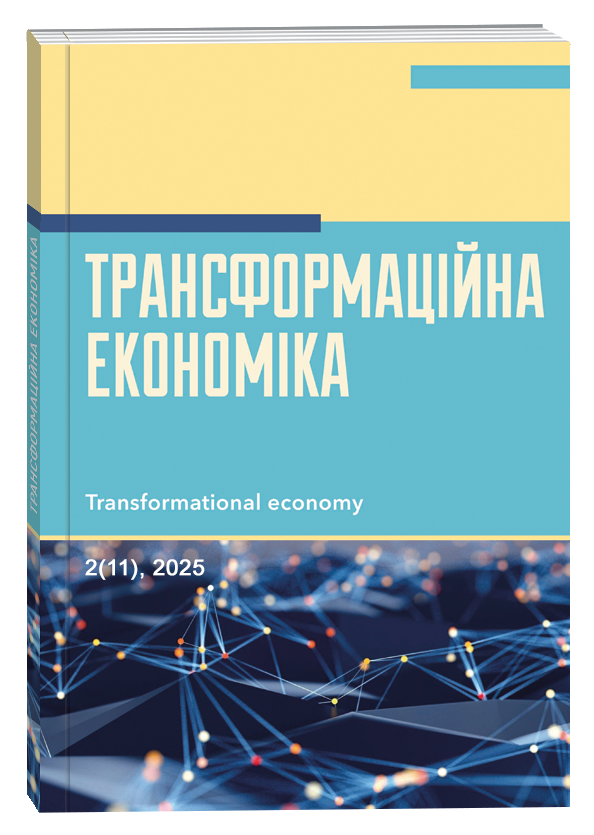STRATEGIC GUIDELINES FOR INNOVATIVE MANAGEMENT DECISION-MAKING IN THE CONTEXT OF DIGITAL TRANSFORMATION
Abstract
The article provides a comprehensive analysis of the transformation of management decision-making processes in a digital environment characterized by high dynamics, growing data volume, multifactorial uncertainty and increased cyber threats. The study is aimed at identifying strategic guidelines that ensure effective innovative management of enterprises in the context of digitalization and technological changes. It is determined that digital transformation is not limited to the implementation of new IT solutions, but involves a deep rethinking of management approaches, structures and the cultural paradigm of the organization. The feasibility of transitioning to modular, dynamic strategies based on the principles of data-driven, agile and anticipatory management is substantiated. An integrated approach to management in the digital age is proposed, which combines digital platforms, adaptive organizational structures, big data analytics, artificial intelligence (AI), the Internet of Things and cloud computing as key factors of efficiency. Particular attention is paid to generative models, which are increasingly integrated into strategic management, acting as tools for decision support, automated analysis of alternatives, risk assessment and scenario forecasting. Separately, the risks and limitations associated with the use of AI in management are investigated, in particular cybersecurity issues, ethical dilemmas, the risk of excessive automation and the emergence of new forms of cyber threats. In the context of increasing the adaptability of organizations to change. Significant emphasis is placed on building a flexible digital infrastructure that includes ERP, CRM, BI platforms and other digital ecosystems for integrated management, as well as the formation of a digital culture focused on continuous learning, innovation and openness to change. The results of the study allowed us to form a model of digital management that takes into account risk factors, uncertainty, cyber threats and ethical challenges. The author emphasizes that such a model should provide enterprises with adaptability, competitiveness and strategic sustainability in a dynamic digital space. The conclusion is made about the need for further interdisciplinary research in the field of digital strategy, data analytics, cyber management and the impact of AI on the transformation of management practices.
References
Porter M. E., Heppelmann J. E. How smart, connected products are transforming competition. Harvard business review. 2014. 92.11. P. 64–88.
Brynjolfsson E., McAfee A. Machine, platform, crowd: Harnessing our digital future. Vol. 4. No. 1. New York: WW Norton & Company, 2017.
Швець Н. Є. Цифровізація управління підприємством: стратегічні орієнтири. Економіка і прогнозування. 2020. № 1. С. 95–108.
Mayer-Schönberger V., Cukier К. Big data: A revolution that will transform how we live, work, and think. Houghton Mifflin Harcourt, 2013.
Davenport T. H., Ronanki R. Artificial intelligence for the real world. Harvard business review. 2018. 96.1. Р. 108-116.
Schwab K. The fourth industrial revolution, Crown Business. New York. 192. 2017.
Rigby D. K., Sutherland J., Takeuchi H. Embracing agile. Harvard business review. 94.5. 2016. Р. 40-50.
Womack JaP., Jones D.T. Banish waste and create wealth in your corporation. 56. 2003. URL: http://www.kvimis.co.in/sites/kvimis.co.in/files/ebook_attachments/James
Bughin J., Why digital strategies fail. McKinsey Quarterly. 2018. 1.1. Р. 14–25.
Коттер Дж. П., Коен Ден С. Серце змін: реальні історії про те, як люди змінюють свої організації. Harvard Business Press, 2012.
Westerman G., Bonnet D., McAfee A. Leading digital: Turning technology into business transformation. Harvard Business Press, 2014.
Lamarre E., Smaje K., Zemmel R. Rewired: the McKinsey Guide to Outcompeting in the Age of Digital and AI. John Wiley & Sons, 2023.
Kotter John P. Leading change. Harvard Business Press, 2012. 194 р.
Csaszar F. A., Ketkar H, Kim H. Artificial Intelligence and Strategic Decision-Making: Evidence from Entrepreneurs and Investors. URL: https://arxiv.org/abs/2408.08811?utm_source=chatgpt.com
Modi А., Kuzminykh І, Ghita В. Data Driven Approaches to Cybersecurity Governance for Board Decision-Making – A Systematic Review. URL: https://arxiv.org/abs/2311.17578?utm_source=chatgpt.com
Куцик П., Ковтун О. Визначення перспективного бізнесу та моделювання оптимальних стратегічних наборів для підприємств з використанням можливостей штучного інтелекту. Цифрова економіка та економічна безпека. 2024. № 5 (14). С. 127–136. DOI: https://doi.org/10.32782/dees.14-20
Куцик П., Лупак Р., Щупаківський Р., Качан О., & Вірт М. (2024). Концептуальні засади узгодження галузевих структурних зрушень із потребами забезпечення конкурентоспроможності економіки в умовах цифрових трансформацій. Financial and Credit Activity Problems of Theory and Practice, 2(55), 346–361. DOI: https://doi.org/10.55643/fcaptp.2.55.2024.4284
Куцик П., Процикевич К. Політика активізації високотехнологічних стартапів у сфері ІКТ: теоретико-методичні засади формування. Економічний аналіз. 2022. Том 32. № 4. С. 256–264. DOI: https://doi.org/10.35774/econa2022.04.256
Porter M. E., Heppelmann J. E. (2014) How smart, connected products are transforming competition. Harvard business review 92.11. P. 64–88.
Brynjolfsson E., McAfee A. (2017) Machine, platform, crowd: Harnessing our digital future. Vol. 4. No. 1. New York: WW Norton & Company.
Shvets N. Ye. (2020) Tsyfrovizatsiia upravlinnia pidpryiemstvom: stratehichni oriientyry [Digitalization of enterprise management: strategic guidelines]. Ekonomika i prohnozuvannia, № 1, S. 95–108. [in Ukrainian]
Mayer-Schönberger V., Cukier К. (2013). Big data: A revolution that will transform how we live, work, and think. Houghton Mifflin Harcourt.
Davenport T. H., Ronanki R. (2018) Artificial intelligence for the real world. Harvard business review 96.1. Р. 108–116.
Schwab K. (2017) The fourth industrial revolution, Crown Business. New York. 192.
Rigby D. K., Sutherland J., Takeuchi H. (2016) Embracing agile. Harvard business review. 94.5. Р. 40–50.
Womack JaP., Jones D.T. (2003) Banish waste and create wealth in your corporation. 56. Available at: http://www.kvimis.co.in/sites/kvimis.co.in/files/ebook_attachments/James
Bughin J. (2018) Why digital strategies fail. McKinsey Quarterly. 1.1. Р. 14–25.
Kotter, J. P., Cohen, Dan S. (2012) Серце змін: реальні історії про те, як люди змінюють свої організації [The Heart of Change: Real Stories of How People Transform Their Organizations]. Harvard Business Press.
Westerman G., Bonnet D., McAfee A. (2014) Leading digital: Turning technology into business transformation. Harvard Business Press.
Lamarre E., Smaje K., Zemmel R. (2023) Rewired: the McKinsey Guide to Outcompeting in the Age of Digital and AI. John Wiley & Sons.
Kotter John P. (2012) Leading change. Harvard Business Press, 194 р.
Csaszar F. A., Ketkar H, Kim H. Artificial Intelligence and Strategic Decision-Making: Evidence from Entrepreneurs and Investors. Available at: https://arxiv.org/abs/2408.08811?utm_source=chatgpt.com
Modi А., Kuzminykh І, Ghita В. Data Driven Approaches to Cybersecurity Governance for Board Decision-Making – A Systematic Review. Available at: https://arxiv.org/abs/2311.17578?utm_source=chatgpt.com
Kutsyk, P., & Kovtun, O. (2024). Identification of promising businesses and modeling optimal strategic sets for enterprises using artificial intelligence capabilities. Digital Economy and Economic Security, (5 (14), 127–136. DOI: https://doi.org/10.32782/dees.14-20
Kutsyk P., Lupak R., Shchupakivsky R., Kachan O., & Virt M. (2024). Conceptual principles of harmonizing sectoral structural shifts with the needs of ensuring the competitiveness of the economy in the context of digital transformations. Financial and Credit Activity Problems of Theory and Practice, 2(55), 346–361. DOI: https://doi.org/10.55643/fcaptp.2.55.2024.4284
Kutsyk P., Procykevych K. (2022). Policy of activating high-tech startups in the ICT sector: theoretical and methodological principles of formation. Economic Analysis. Vol. 32. No. 4. P. 256–264. DOI: https://doi.org/10.35774/econa2022.04.256


